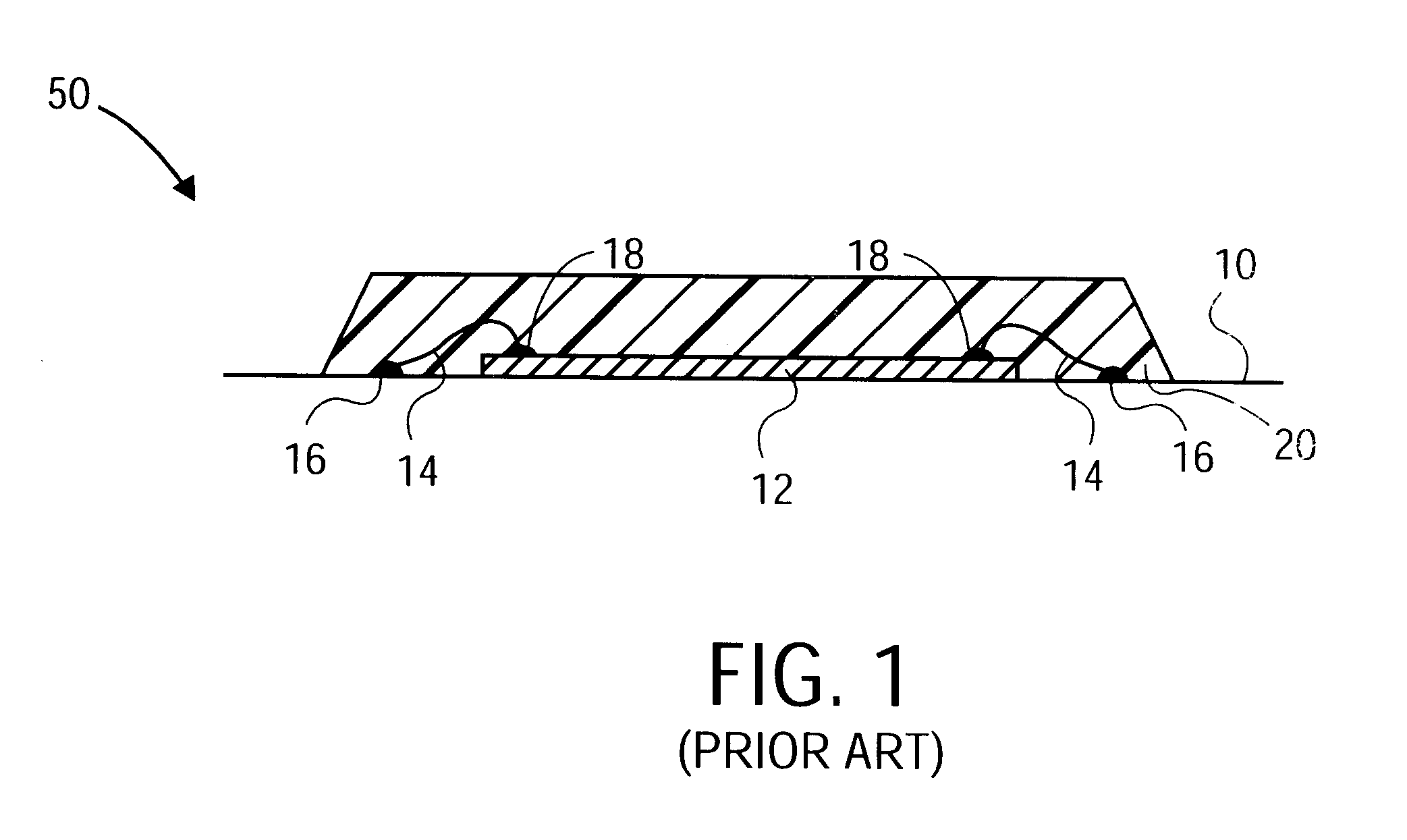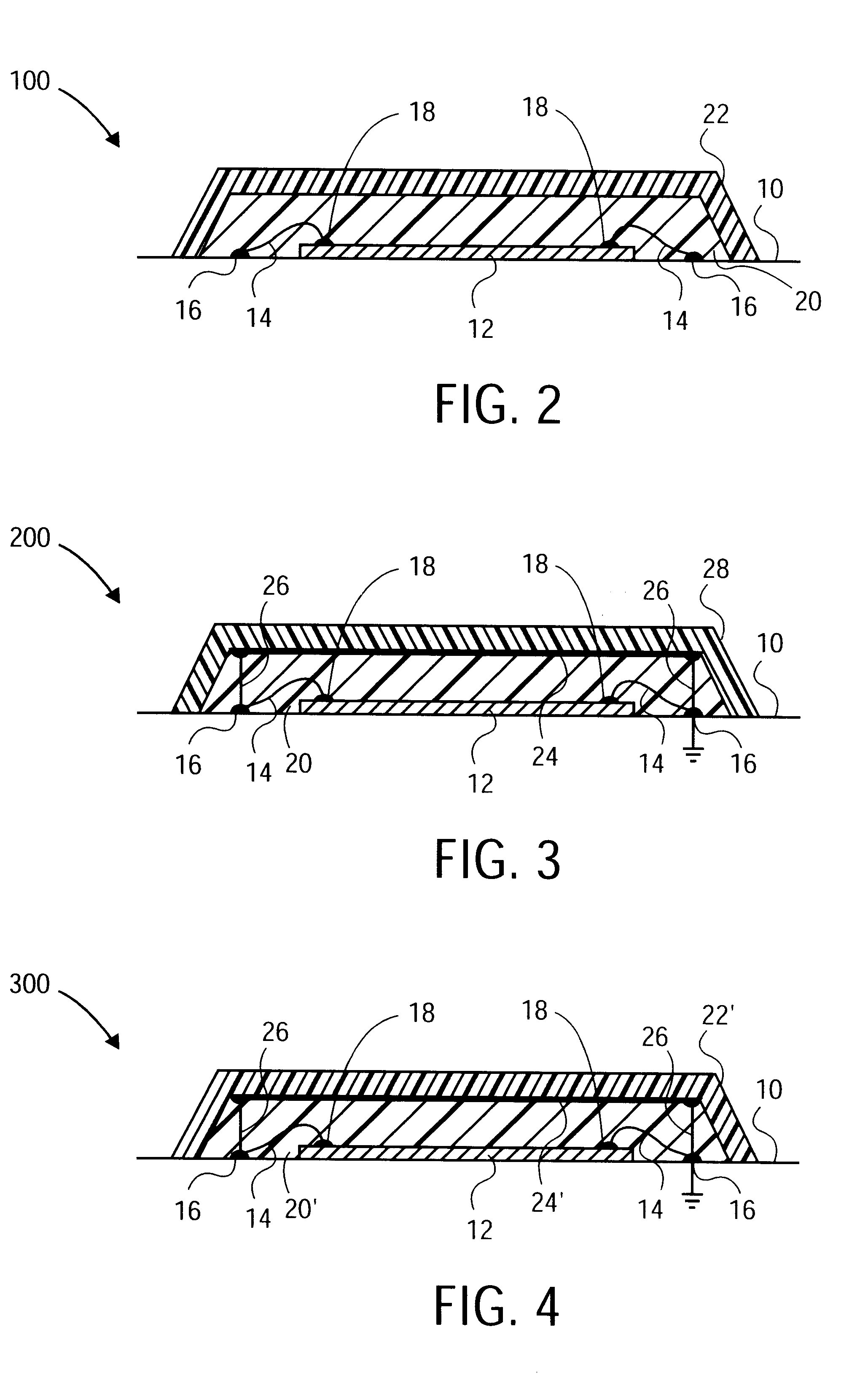Magnetic and electric shielding of on-board devices
a technology of magnetic and electric shielding, which is applied in the direction of semiconductor devices, semiconductor/solid-state device details, electrical apparatus casings/cabinets/drawers, etc., can solve the problems of assisting a given system in achieving compliance with the fcc open box regulations
- Summary
- Abstract
- Description
- Claims
- Application Information
AI Technical Summary
Problems solved by technology
Method used
Image
Examples
first embodiment
Reference is now made to FIG. 2, which shows a system 100 encapsulating the device 12 on the surface 10 of a device board (i.e., the device 12 may be an on-board device) in accordance with a first embodiment of the invention. The system 100 is somewhat similar to the system 50 except for the provision of a "tertiary" layer 22 that encapsulates or covers completely, or covers a portion of (e.g., a substantial portion of), the primary layer 20 (the layer 22 is termed "tertiary" for reasons set forth below). Covering only a portion may be due to, for example, air bubbles, imperfections, or it may be done by design. However, for shielding purposes, complete or substantial covering, as understood by those skilled in the art in the context of the present invention, may be desirable to maximize shielding. (This discussion of covering applies to all embodiments of the present invention, and for any type of covering layer, not just those of the first embodiment.) The tertiary layer 22 may be...
second embodiment
Referring now to FIG. 3, a system 200 is shown in accordance with a second embodiment of the invention. The system 200 is somewhat similar to the system 100, but the system 200 does not include the tertiary layer 22. Instead, the system 200 includes a "secondary" layer 24 that is electrically conductive, and may be highly conductive. The secondary layer 24 is adjacent or layered on the primary layer 20 encapsulant, and may completely cover, or cover only a portion of, the layer 20. The secondary layer 24 also includes conductive shielding contacts or sections 26 coupled to the contact 16 which, in turn, are coupled to a device board ground (not shown in specific detail). The device contact 18 may also be coupled via the bond wire 14 to the device board ground. An encapsulant layer 28 is included that is adjacent or layered on (and covers all of, or a portion of, e.g., a substantial portion of) the secondary layer 24 and the primary layer 20, such that the secondary layer is disposed...
third embodiment
Referring now to FIG. 4, a system 300 is shown in accordance with a third embodiment of the invention. The system 300 incorporates all the functionality of, and similar features to, both the systems 100 and 200 shown in FIGS. 1 and 2. The system 300 includes a primary layer 20' (similar to the primary layer 20), a secondary layer 24' (similar to the secondary layer 24), and a tertiary layer 22' (similar to the tertiary layer 22). The secondary layer 24' is adjacent or layered on (completely covering, or covering a portion of, e.g., a substantial portion of) the primary layer 20', analogous to the layering of the secondary layer 24 on the primary layer 20 in the system 200. Moreover, the tertiary layer 22' is adjacent or layered on (completely covering, or covering a portion of, e.g., a substantial portion of) the secondary layer 24', such that the secondary layer is disposed between the tertiary layer 22' and the primary layer 20', analogous to the layering of the encapsulant layer ...
PUM
 Login to View More
Login to View More Abstract
Description
Claims
Application Information
 Login to View More
Login to View More - R&D
- Intellectual Property
- Life Sciences
- Materials
- Tech Scout
- Unparalleled Data Quality
- Higher Quality Content
- 60% Fewer Hallucinations
Browse by: Latest US Patents, China's latest patents, Technical Efficacy Thesaurus, Application Domain, Technology Topic, Popular Technical Reports.
© 2025 PatSnap. All rights reserved.Legal|Privacy policy|Modern Slavery Act Transparency Statement|Sitemap|About US| Contact US: help@patsnap.com



